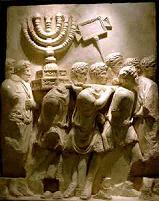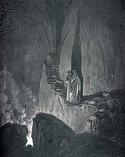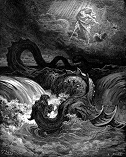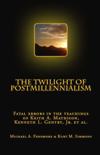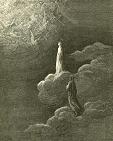Symbolism of Heavens and Earth:
National & Political, or Covenantal?
Kurt Simmons
Like the question which death was destroyed in AD 70 (Ans: Hadean), the proper interpretation of the symbolism behind use of “heavens and earth” in prophetic imagery is becoming more and more important to Preterism. In this article, we show that the prophets consistently use the imagery of the heavens and earth as symbols of thrones and dominions, and peoples and nations, and never in reference to the Old or New Testament.
The probable majority of Preterists interpret the “heavens and earth” of New Testament prophecy as symbolic references to Jerusalem, the temple, and the Mosaic law. This interpretation reflects apologetic attempts to harmonize passages like II Peter 3 with predictions tying Christ’s return to the fall of Jerusalem. The apostles sat upon the Mount of Olives and asked Jesus about the sign of his coming and the end of the world; he answered by describing events largely confined to the fall of Jerusalem. Add to this passages like Heb. 12:27, which describes a shaking of the heavens and earth in connection with the removal of the old law, and the conclusion seems inescapable: The heavens and earth of New Testament prophecy should be understood as metaphors for Jerusalem and the old law.
This view has had notable proponents over the centuries. Names like John Owen, John Lightfoot, Jonathan Edwards, and Charles Spurgeon can be marshaled in at least partial defense of this position. Given the prominence the fall of Jerusalem and the temple receive in scripture, we feel it is natural – perhaps even unavoidable - for students to reach this conclusion early in their studies. Indeed, this was our view for almost 25 years. More recently, however, we have come to reject it as scripturally indefensible.
Established Usage
Consistent use of “heavens and earth” by the prophets shows that it was always used nationally and politically, never locally or “covenantally.”
There is not a single occurrence in the Old Testament where “heavens and earth” are used as symbols or metaphors for the law of Moses, temple service, or priesthood. Not one. All instances are strictly confined to instances of world-wide judgment upon men and nations.
Isa. 13:9-11 - Behold, the day of the LORD cometh, cruel both with wrath and fierce anger, to lay the land desolate: and he shall destroy the sinners thereof out of it. For the stars of heaven and the constellations thereof shall not give their light: the sun shall be darkened in his going forth, and the moon shall not cause her light to shine. And I will punish the world for [their] evil, and the wicked for their iniquity; and I will cause the arrogancy of the proud to cease, and will lay low the haughtiness of the terrible.
This is a classic Preterist proof text; it has been used innumerable times to show that there have been many comings and days of the Lord, and that the language of a collapsing universe is purely figurative. We call to your attention two additional points, generally overlooked:
1) There is no covenantal aspect to this prophecy. God’s wrath is based exclusively upon his moral judgments against the wickedness of man, not the Mosaic law. The especial object of judgment in this passage is Babylon, which was never in covenant relation with God. The figure of the heavens and earth in this passage is therefore easily seen to be national and political; it describes the overthrow of thrones and dominions, not the temple or its service.
2) This prophecy reflects a time of world-wide judgment. Isaiah specifically states that the fall of Babylon was merely part of a larger time of world-wrath at the hands of the Medes and Persians. The Mede-Persian Empire was like a great whirlwind of destruction that ranged from Elam in the North to Egypt in the West, and Arabia in the south to Europe in the north. No nation escaped; all felt the rod of God’s chastisement by their hand.
Isa. 34:1-4 - Come near, ye nations, to hear; and hearken, ye people: let the earth hear, and all that is therein; the world, and all things that come forth of it. For the indignation of the LORD [is] upon all nations, and [his] fury upon all their armies: he hath utterly destroyed them, he hath delivered them to the slaughter. Their slain also shall be cast out, and their stink shall come up out of their carcases, and the mountains shall be melted with their blood. And all the host of heaven shall be dissolved, and the heavens shall be rolled together as a scroll: and all their host shall fall down, as the leaf falleth off from the vine, and as a falling [fig] from the fig tree.
Here is another classic Preterist proof text. Its power and testimony to the figurative nature of prophetic imagery and language is unequaled. It corresponds perfectly with Matthew twenty-four, II Peter 3, and the imagery of Revelation. Despite the language of collapsing universe, the specific object of wrath named in this passage is Edom. However, in our haste we have overlooked several things:
1) The passage expressly describes a time of world-wrath by the Babylonian Empire; Edom would fall in the course of God’s judgment upon the nations.
2) Its language is clearly national and political, not covenantal. The judgments described had no connection to the Old Testament law.
Of course, there are passages identical to these, which describe judgment upon Old Testament Judea by the Babylonians; events that occurred within the very sweep of the prophecy concerning the fall of Edom, above. For example, Zephaniah describes God’s judgment upon Judah in similar language. However, the same book also describes simultaneous judgment upon numerous other cities and nations, including Gaza, Ashkelon, Ashdod, Ekron, the Cherethites, Canaan, the Philistines, Moab, Ammon, and the Ethiopians! Although judgment upon Judah necessarily involved the nation’s violation of the old law, the fact that identical language is used to describe judgment upon nations to whom the law did not apply proves that it is national and political, not covenantal; the fall of stars from the heavens and the dissolution of the earth describe the overthrow of thrones and dominions, and have no reference to the Old Testament at all.
Planting the Heavens & Founding the Earth
Isaiah fifty-one is another favorite text, supposedly affirming that “heavens and earth” carry a covenantal connotation. However, an objective reading of the text will show this is wrong:
“For the Lord shall comfort Zion: he will comfort all her waste places; and he will make her wilderness like Eden, and her desert like the garden of the Lord….Therefore the redeemed of the Lord shall return, and come with singing unto Zion; and everlasting joy shall be upon their head: and they shall obtain gladness and joy; and sorrow and mourning shall flee away…The captive exile hasteneth that he may be loosed, and that he should not die in the pit, nor that his bread should fail. But I am the Lord thy God, that divided the sea, whose waves roared: The Lord of hosts is his name. And I have put my words in thy mouth, and I have covered thee in the shadow of mine hand, that I may plant the heavens, and lay the foundations of the earth, and say unto Zion, thou art my people.” Isa. 51:3, 11, 14-16.
Reference to the sea is correctly identified with God’s parting the Red Sea for Israel at the exodus. This is then typically coupled with the language about “planting the heavens,” and “laying the foundations of the earth” as evidence that “heavens and earth” here refers to establishing the covenant at Sinai. However, this is really very bad exegesis, and belies a fundamental lack of comprehension. The context of the passage is plainly to the Babylonian captivity and God’s promise to bring a remnant back to the land. Notice that reference to dividing the Red Sea is in the past tense, indicative mood. Note also that reference to “planting the heavens” and laying the “foundations of the earth” is in the future subjunctive (“that I may”). This shows that these two events are not connected in time; God is evoking the example of the Red Sea crossing from the past as a demonstration of his ability to redeem his people out of captivity in the future. “Planting the heavens” is a poetic reference to repopulating the land by sowing it with the seed of men; “laying the foundations of the earth” describes the rebuilding of the waste and desolate places; the cities left uninhabited when their peoples were taken into captivity. This is easily seen by a simple comparison of similar passages. (Cf. Jer. 31:27; Ezek. 36:33, 36; Hos. 2:23)
Hebrews: Shaking the Heavens & Earth
It is true, of course, that Hebrews speaks about shaking the heavens and earth in the context of the destruction of Jerusalem (Heb. 12:22-28). This is cited by Preterists as evidence that the heavens and earth to be removed were covenantal, and referred to the Old Testament, and that the new heavens and earth refer, in turn, to the New Testament. Thus, Max King:
“The writer of the Book of Hebrews referred to this transformation as the shaking of heaven and earth, which signified the removing of the temporal Old Covenant world that was created at Mount Sinai (Hebrews 12:26-27)...The destruction of Jerusalem and the earthly temple in A.D. 70 provides the context for the passing of the old heaven and earth...He sums up the new creation in terms of the coming of the kingdom of God in power by writing, “since we are receiving a kingdom that cannot be shaken, let us give thanks, by which we offer to God an acceptable worship with reverence and awe” (Hebrews 12:28). Max R. King, Israel's New Heaven and Earth, Mar 26, 2005
However, this is plainly wrong. Shaking of the heavens and earth at the eschaton was in no wise limited to Jerusalem and the Jews. The eschaton was a time of world-wrath, reaching from Italy, Spain, Germany, and Gaul, to Armenia, Asia, Egypt, and Palestine. One would have to be ignorant of world history at the time of Jerusalem’s fall not to see this. He would also have to be willing to overlook numerous passages of scripture that plainly signify the world-wide nature of the eschaton. Haggai, whom the writer of Hebrews quotes, provides its own best refutation of the “local” and “covenantal” eschaton model.
Hag. 2:6, 7; 3:21, 22 – For thus saith the Lord of hosts; Yet once, it is a little while, and I will shake the heavens, and the earth, and the sea, and the dry land; and I will shake all nations, and the desire of all nations shall come: and I will fill this house with glory, saith the Lord of hosts…I will shake the heavens and the earth; and I will overthrow the throne of kingdoms, and I will destroy the strength of the kingdoms of the heathen.”
As Preterists, we have interpreted this passage as quoted by the Hebrew writer in terms of Jerusalem’s fall, but, as we see, its actual, original, and intended scope was universal – the eschaton would be a time when all nations of the greater Roman world were shaken and the throne of heathen kingdoms overthrown. We should also note that the heavens and earth in this context point to higher powers and earth’s governments; they have no covenantal significance whatever.
The number of passages proving the eschaton was in no way localized to Judea and Galilee are so many it is almost tedious to read and recount them. Nevertheless, we provide here a few. Dan. 2:28-45; 7:1-28; Ps.2:8, 9;. 96:11-13; cf. 98:9; 110:5, 6; Ezek. 38, 39; Joel 3; Mic. 4:3, 11-13; Zech. 12:3; 14:12; Matt. 25:31, 32; Rom. 1:18; Rom. 2:8, 9; I Cor. 7:29, 31; II Thess. 2:8; II Tim. 4:1 Acts 17:30, 31; Revelation. It is axiomatic that if the eschaton involved the whole Roman world, then the heavens and earth dissolved at Christ’s coming was much more than Judea.
Isaac Newton: Heavens & Earth National and Political
We noted above that many great names down through the centuries have interpreted the heavens and earth of II Peter three and Hebrews twelve in reference to the fall of Jerusalem, while overlooking Christ’s wrath upon the rest of the Roman world. However, with the possible exception of Lightfoot, none of those cited interpreted the heavens and earth in “covenantal” terms, so far as we are aware. And even Lightfoot interpreted only the “elements’ in reference to the Mosaic law, not the “heavens and earth.” Hence, even these great commentators would agree that “heavens and earth” refer to thrones and dominions, not the Old or New Covenants.[1] The following explanation by Isaac Newton we submit is the correct one.
"The figurative language of the prophets is taken from the analogy between the world natural and an empire or kingdom considered as a world politic. Accordingly, the world natural, consisting of heaven and earth, signifies the whole world politic, consisting of thrones and people, or so much of it as is considered in prophecy; and the things in that world signify the analogous things in this. For the heavens and the things therein signify thrones and dignities, and those who enjoy them: and the earth, with the things thereon, the inferior people; and the lowest parts of the earth, called Hades or Hell, the lowest or most miserable part of them. Great earthquakes, and the shaking of heaven and earth, are put for the shaking of kingdoms, so as to distract and overthrow them; the creating of a new heaven and earth, and the passing of an old one; or the beginning and end of a world, for the rise and ruin of a body politic signified thereby. The sun, for the whole species and race of kings, in the kingdoms of the world politic; the moon, for the body of common people considered as the king's wife; the stars, for subordinate princes and great men; or for bishops and rulers of the people of God, when the sun is Christ. Setting of the sun, moon, and stars; darkening the sun, turning the moon into blood, and falling of the stars, for the ceasing of a kingdom." (Observations on the Prophecies, Part i. chap. ii)
If the heavens and earth put down at Christ’s coming were the throne and dominions of Nero Caesar, the Sanhedrin and rulers of the Jews, together with other temporal powers who rejected the gospel and persecuted the church, then the new heavens are earth are best understood as the government of Christ, ruling the nations in righteousness with an iron rod.
Covenantal Heavens & Earth: All the Rage among Universalists
It is no secret that Presence Ministries of Max R. King, who has built his built his writing career on the covenantal heavens and earth model, has gone over to Universalism. The number of articles and quotes that may be marshaled in support of this charge make it beyond successful refutation. Indeed, Presence Ministries feels no need to even deny the accusation by issuing a statement or disclaimer. We here provide quotes from Universalists of varying shades and colors, all of whom make happy use of the covenantal heavens and earth concept to advance their cause. The last quote is by Tim Martin; although not a Universalist, his theology nevertheless bears an obvious logical connection thereto. All the people quoted accept the basic covenantal heavens and earth model of King. Please note the progression of thought:
Tim King[2] - “Simply stated, man is changed because his world changed. Man is reconciled to God because he no longer lives under the rule of sin and death as determined by the Mosaic world. Through the gift of Christ he dwells in a world of righteousness and life. The issue is cosmic and corporate, not individual and limited.” Tim King, Comprehensive Grace, 2005
Kevin Beck[3] - “There’s no sin and no sin-related death in a world that has the New Jerusalem in it’s midst.” Kevin Beck, The Creation of Jerusalem, Feb, 08
David Timm[4] - The second Adam (Christ) reversed all the spiritual separation brought by the first Adam, not just part of it…in the new world people are reconciled to God without any say in the matter. God loves all those that He has made in His image equally. David Timm, Grace Upon All, Oct. 2006
David Embury[5]- "A man was who he was according to his 'world', and for the Jews their world centred around Yahweh - they were His people and He their God, and so by covenant. Who were the first-fruit believers in Paul's eyes? None other than the 'Body of Christ'. Having been crucified, buried and raised in Christ they were thus delivered out of the body of sin and death i.e., the Old Covenant world, or what we might call the 'Body of Moses' – Paul having spoken of "the fathers" being "baptized into Moses" etc. [can you see the train of thought?] The designation "the flesh" is not one facet of man as opposed to another part of man i.e., "the spirit", but rather "the flesh" speaks of man as a whole in a given mode or realm of existence, as does likewise the spirit. So Paul's spirit/flesh language was indicative of life under covenant, either of the "flesh" as in OC or of the "spirit" as in NC – reading Gal 3 and Phil 3 bears this out." David Embury, Plantet Preterist post, Friday, December 05 @ 20:23:16 PST
Ed Burely[6] – “In spite of the fact that I do not believe that the first chapters of Genesis have anything to do with the physical creation (but instead with a covenant creation), I still will not buy an argument that says "young earth" but not with biblical evidence. A covenantal view of the bible's beginning, along with scientific data, speaks to me that this earth, and this universe is old." Ed Burely, Planet Preterist, Tuesday, November 13 @ 10:56:06 PST
Tim Martin[7] - "Just as the formation of Israel and giving of the Law was the metaphorical creation of “heaven and earth,” so the destruction of the Judaic society, the Law, the priesthood, and temple would be the passing away of Israel’s “heaven and earth.” Tim Martin, Beyond Creation Science (unpublished manuscript version)
“Do you believe that there were any people outside of the garden at creation? If all were in the garden in God's first (what you take to be physical) creation, wouldn't that have implications for God's redemption?...As you can see, it could be that it's never been about us doing anything (right or wrong); it's always been about God redeeming his creation; not just small parts of it.” Tim Martin, Planet Preterist Post, Thursday, February 21 @ 09:48, 52:05 PST
“Redeeming all of his creation” means all in the “covenant creation” (“covenantal heavens and earth”). Thus, to avoid the Universalism inherent in placing all men in Revelation’s new heavens and earth (where these are interpreted as the New Testament), Martin is forced to place other men outside of his “covenantal garden of Eden.” Tim King and Kevin Beck, on the other hand, make no qualms that all mankind is redeemed in the new heavens and earth. Such is the mischief the covenantal heavens and earth model has wrought.
Conclusion
Established usage shows that “heavens and earth” were metaphors for thrones and dominions, peoples and nations. They have never had any covenantal signification in scripture. Preterists need to disabuse themselves of this erroneous idea.
[1] 'It is evident, then, that in the prophetical idiom and manner of speech, by heavens and earth, the civil and religious state and combination of men in the world, and the men of them, were often understood. So were the heavens and earth that world which then was destroyed by the flood.
' On this foundation I affirm that the heavens and earth here intended in this prophecy of Peter, the coming of the Lord, the day of judgment and perdition of ungodly men, mentioned in the destruction of that heaven and earth, do all of them relate, not to the last and final judgment of the world, but to that utter desolation and destruction that was to be made of the Judaical church and state.’ John Owen, Sermon on II Peter 3:11.
[2] Tim King is Max King’s son and former president of King’s Presence Ministires
[3] Kevin Beck is president of Presence Ministries
[4] David Timm is author of a Universalist article entitled Grace Upon All was posted by Presence Ministries in October, 2006.
[5] Embury espouses a form of Universalism he styles “pantelism.”
[6] Burley is author of The Death of Death, an article affirming all who were dead in Adam are now alive in Christ, regardless of faith or obedience. The Death of Death posted on Planet Preterist, Wednesday, February 25 @ 07:10:51 PST
[7] Martin is co-author of Beyond Creation Science, a book that synthesize King’s Covenant Eschatology and with Old Earth Creationism and a local (vs. universal) flood.
To receive Kurt Simmons’ e-mail newsletter, The Sword & The Plow, click the Subscribe link:
All rights reserved.
